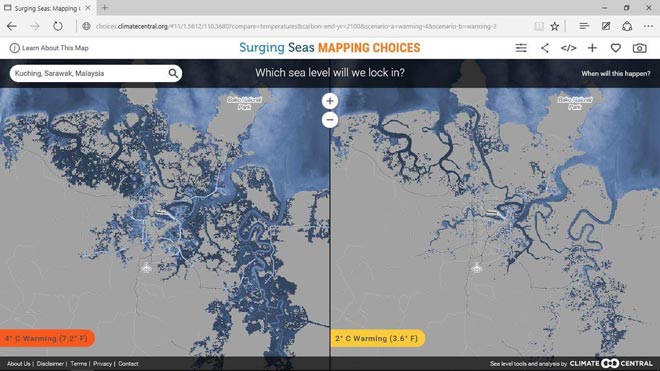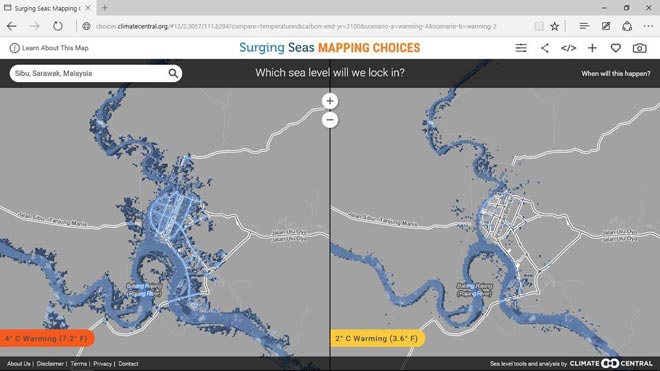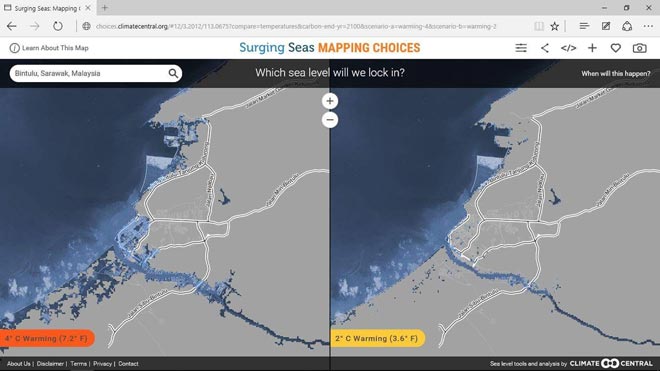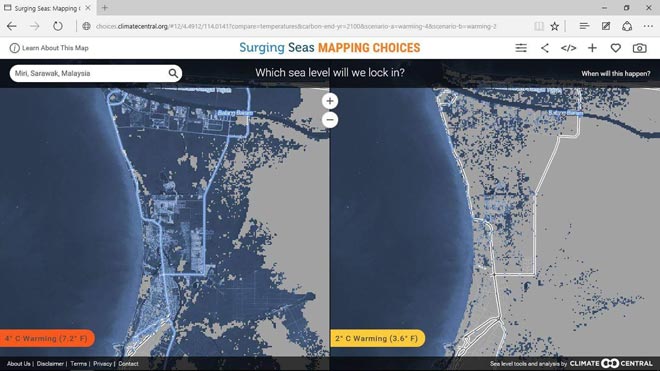



The image on the left of each photo is the projection of sea level rise by 2100, following a four-degree Celsius of warming from carbon pollution in the coming decades. The images on the right show the projection if temperature rise is managed to be kept on track on the two-degree Celsius target. The images from top left (clockwise) show the map of Kuching, Sibu, Bintulu and Miri as depicted by Climate Central on Mapping Choices website.
KUCHING: The current emission rate of carbon dioxide (CO2), if left uncontrolled, could threaten the existence of coastal towns and cities around the world, including those along the shores of Sarawak.
According to a recent study by Climate Central — a research group comprising scientists and science journalists, carbon emissions causing a four-degree Celsius rise in temperature (the current rate that the world is seeing) could raise global sea level by 6.9m or even up to 10.8m – enough to submerge a land area populated by at least 470 million people.
Closer to home, Sarawak might be looking at the same sea-level elevation, depending on the rise in temperature, said Shun Deng Fam, who had previous involvement in climate change projects at the National University of Singapore.
“If we cut carbon emissions aggressively worldwide, we can keep it to two degrees Celsius rise but the current rate of greenhouse gas production means that we are heading for a four-degree Celsius rise in global temperature,” Shun, who is doing his PhD at the Australian National University, told The Borneo Post yesterday.
He was commenting on the climate projection maps released by Climate Central on Monday, which estimated global sea-level rise by 2100.
The maps are displayed at Mapping Choices; an interactive tool that allows users to explore the possible consequences of a four-degree Celsius warming, two-degree Celsius warming and other temperature or carbon emission scenarios around the world. The map shows how coastal areas across the globe could fare under the current rate of CO2 emission against a sharp transition to clean energy.
Climate Central mentioned that a sharp transition to clean energy or aggressive carbon cuts could reduce carbon emissions to a two-degree Celsius warming, which is the well-established international target and lowering the rise of sea-level to about three metres.
Shun believes that local politicians and scientists would need to come together to better understand how the various climate scenarios affect the state and prepare for mitigation measures. Under the worst case scenario, he cautioned that Sarawak could be disproportionately affected.
He also cautioned that the state’s capital city (Kuching) and three other towns (Sibu, Bintulu and Miri) as well as the Sarawak Corridor of Renewable Energy (SCORE) growth nodes of Tanjung Manis and Mukah could potentially be submerged.
He pointed out that climate change was seldom talked about in Sarawak-specific terms, as the subject might be seen as part of national development strategies, and international news agencies were more concerned with the great metropolitan cities of London, New York or Shanghai. Therefore, the state should find its voice and join the push for greater climate action, he advised.
“The state may only have two million people but its natural beauty, its economy and the history of its diverse coastal communities are under siege. Of course, there is also a need to play a part for the greater good. Reduction of greenhouse gas emissions by conserving rainforests, efficient public transport and public utilities should be the way forward.
“Much need to be done in Sarawak and the people should be made much more aware of the climate change, its impact and how to contribute to the fight against this problem. The change will not happen tomorrow, so there is time for Sarawak to react,” he continued.
